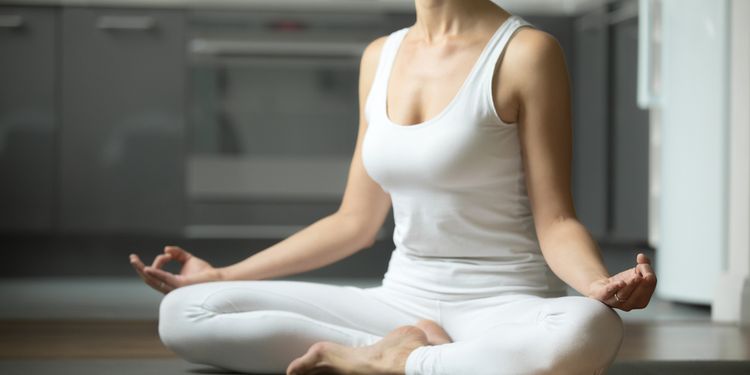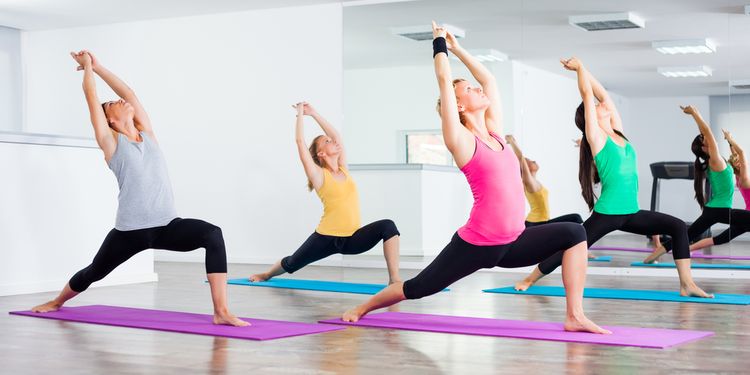7 Meditation Practices That Can Change Your Life

The stresses of daily life can lead to irritability, restlessness, an inability to make decisions, and a general feeling of being overwhelmed. We all know that slowing down, even just to take a few deep breaths, can make us feel much calmer. But when the idea of sitting in a quiet, spa-like environment seems like just another thing to add to your already overloaded to-do list, what’s your best course of action?
As it turns out, meditation could be the answer. It can be done in a number of ways and locations and could have a real, lasting effect on your brain. Although science can’t quantify how the brain changes from mindful meditation, research shows that regular meditation could actually make you more attentive and better able to process daily life.1
It’s widely accepted that chronic stress has long-term negative effects. Studies show that decreased cognitive ability—and perhaps even impaired memory as we age—could all be the result of staying too stressed out.2 In addition, stress can interfere with our immune response, make us crave foods that aren’t good for our overall health, cause brain fog, and even get in the way of a good sex life.3
According to Dr. Frank Lipman, “The way you respond to stressful situations can have a major impact on your health, so finding ways to counteract its effects is critical to your overall well-being.”4
You Can Meditate. Yes, YOU.
Stress reduction through meditation is easy and accessible to anyone. Research has shown that people who have meditated over a number of years have a more robust subiculum, the part of the brain that controls attention, memory, spatial navigation, and stress management.5
Meditation has the ability to help us access deep inner healing that could bring forth real, lasting changes in our behaviors. It could help you achieve goals, relieve anxiety surrounding medical procedures, improve your concentration, and lift your mood.
Let’s look at seven different kinds of meditation practices and how they can improve your quality of life.

Practice #1: Mindfulness Meditation
Mindfulness is a form of meditation that requires you to notice your thoughts and detach from them in the moment. Even five minutes of meditation could help you relax. This type of meditation is good for first-time meditators.
To begin meditating in this way, find a quiet place to sit with your back straight.
Take a deep breath and plant your feet firmly on the floor.
Observe where your body feels strong, and be gentle in your thoughts toward yourself in any areas that you might wish were healthier.
Ignore the list of items you might have to accomplish for the day and choose one element of your life you’re grateful for.
Dr. Mark Hyman, an advocate for meditation and healthy living, tells us to “wake up with gratitude and lightness and celebration for the magic of life. It’s always there, and the trick is simply to notice it.”6
Take deep breaths. Notice how the breath feels moving in and out of your nostrils. Feel your belly move with the breath. Focus on that. It’s completely normal to have thoughts during your meditation.
Once your five minutes are complete, make a mental note of how your mind and body feel. If you find a period during the day where you’re experiencing any stress, try to guide your mind back to the way you felt upon completing your meditation.

Practice #2: Movement Meditation
A meditative state can be achieved through the simple act of focusing your mind while doing another activity.
This type of meditation is good for people who are normally active. Anything that allows you to free up your mind from its cascade of thoughts can be considered meditation.
Think of this as exercising your right to have a peaceful mind. Even the simplest form of movement can be a powerful motivator. Ponder what Mark Sisson says: “Movement is the first step above sedentarism. It’s the baseline for good health. It’s the 10,000 steps a day, the hiking, the walking to the store, the gardening, the commute to work on a bike. Movement is required for good health.”7
When using movement as your meditation, the key is to focus on being present with yourself and what you’re doing. Begin by choosing an activity that you enjoy.
Let’s use a walk as an example. Notice how you feel as you breathe in the fresh air. Really take in the feeling of your muscles working as you take each step. Concentrate on what it means to be healthy and able to walk. Thoughts will arise like clouds drifting across the sky. Let them drift past. Continue your focus on the actual event of walking.
Movement meditation comes in many varieties: walking, riding a bike, kayaking, gardening, running, stretching, fishing, a daily workout, even yoga. We’ll look at yoga in further detail as its own form of meditation.

Practice #3: Yoga
Yoga became a popular form of exercise in the Western world in the 1980s, and class offerings can now be found at many local gyms, at yoga studios, through online channels, or even at the office.
Workplace yoga has been shown to reduce stress during the work day.8 Yoga is a form of stretching exercise that’s good for easing tight muscles, although the original intent of yoga was a more spiritual practice.
You may worry that you don’t have the physical strength or flexibility to begin doing any kind of stretching, much less yoga. As with any discipline, it takes time and practice to become proficient. Be patient with yourself. If you’re not comfortable doing yoga in a class setting, consider finding a beginner’s instructional video.
The beauty of yoga, even in a class full of others, is that it’s a very individualized experience. Yoga isn’t about competing with any other person or about being the best. It’s about helping you become better in your own right.
Yoga can help you re-establish the connection between your mind and body. It can also help you become more physically and mentally agile. It’s known to shift your mood, help with digestion, ease you out of tiredness, elevate your mood, and relax you.9
Focusing on your breath and noticing what your body is capable of each time you’re on your yoga mat establishes a benchmark for future success within your practice. Yoga is good for all levels of meditation experience.

Practice #4: Guided Meditation
Every day, we’re connected via our phones, tablets, computers and televisions to the outside world and all that it has to offer.
Consider using one of your devices to discover the world of guided meditation. This form of meditation requires only your ability to listen and a willingness to let someone guide you.
Nature sounds or soothing instrumentals may accompany the voice of your guide. You’ll be invited to sit or lie down in a comfortable position, with your eyes closed and your mind quiet. After taking some cleansing breaths, you’ll be led through a series of scenes to imagine, each inviting a deeper sense of relaxation.
In this restful state of mind, you may be able to envision goals you want to achieve or new ways of being. Studies also show that guided meditation can help reduce sustained musculoskeletal pain.10
Guided meditations can be found online, on a CD, through many mobile apps, and through media-for-purchase sites. One of the most popular websites/apps is Headspace: Meditation, which is great for all levels. Guided meditation can be done by a novice or expert meditation practitioner and can be effective in reducing stress.

Practice #5: Visualization Meditation
Visualization meditation takes very little to get started, but does require a specific intention by the person meditating. Deepak Chopra reminds us, “You can do a simple meditation where you quiet your mind, put your attention in your heart, and just ask yourself ‘what am I grateful for?’ … This kind of thing actually has very powerful biological consequences.”11
Visualization meditation can be done for 5 to 60 minutes. You can start this practice like many of the others outlined here by sitting quietly with a straight, relaxed back and a purpose for your practice.
It’s best to begin visualization meditation with a general concept or idea. Perhaps you imagine that you want more happiness in your life. Begin with a deep breath and a phrase that depicts you already being in that state. “I am happy.” As you breathe in and out, continue to picture yourself as already having attained the object of your meditation.
Dr. Kelly Brogan advises using meditation as a new way to look at “approaching conflict, tension, and stress with a renewed mindset.”12

Practice #6: Mantra Meditation
Mantra meditation uses the silent repetition of a particular sound, often words from Sanskrit, such as “Om,” “Ah,” and “Hum.”
The purpose of a mantra is to help lead your mind back to the present and to the intention that you’ve set for your meditation.
When a thought arises, the mantra helps you have something from which to regain your focus. Mantra meditation is often in guided form as well, with an instructor introducing the mantra, and is sometimes set to music.
It can be easy during the beginning stages of meditation practice to lose focus. You might notice that your mind wanders off in many different directions. Setting an intention each time you meditate could help with this.
For instance, you could set an intention that you wish to be stress-free during an upcoming meeting, or during a difficult conversation, or while driving to work. Once the intention has been set and the mind focused, begin mantra meditation. Consider mantra meditation when you have at least twenty minutes to spare where you can sit quietly.

Practice #7: Binaural Beats
Meditating to music can produce extraordinary feelings of tranquility. Specifically, music that has embedded binaural beats can be used as a means of training yourself to meditate more effectively.
Binaural beats work by producing sound as a stimuli that help your brainwaves fall into a specific pattern. You “hear” the beats between the frequencies at a rate equal to the difference of the frequencies between the tones.13 What does that mean to you? It means that you’ll get extremely relaxed using binaural beats.
This type of meditation is good to use if you have trouble sleeping, if you’d like to help slow your heart rate down to reduce stress and promote positive feelings, or if you generally just want to chill out. Using this technique with hospital emergency room patients was shown to reduce anxiety levels by 10%–15%.14 Binaural beat meditation is suitable for any level of meditation student.
Get Started
The key to meditation is to simply get started. Like anything worthwhile, it takes practice. Not to be confused with effort, practice is about developing routine, familiarity and comfort. It’s easy to say that meditation is new-age, woo-woo, not for you, or that you simply can’t sit still for long enough to make it work. The reality is that anyone can do it, even you. World-class athletes, CEO’s and everyday people all over the world turn to mediation each and every day. Why not you?
